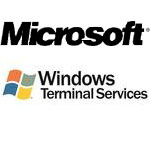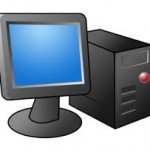 Microsoft Terminal Services (now known as Microsoft Remote Desktop Services) results in a highly cost effective management of your company’s end-user desktop infrastructure at a much lower cost than the alternative of using individual dedicated PCs.
Microsoft Terminal Services (now known as Microsoft Remote Desktop Services) results in a highly cost effective management of your company’s end-user desktop infrastructure at a much lower cost than the alternative of using individual dedicated PCs.
The following areas and benefits are covered in this article:
- Implementation process & cost
- Application software management
- Cost of adding PCs versus thin clients
- Hardware failures: PC versus thin client
- Enhanced security & easier management
- Increased mobility
- Performance, scalability & redundancy
- Hardware upgrades
- When Remote Desktop Services is not a good solution
Implementation process & cost
There are two areas where implementing Remote Desktop Services typically reduces cost.
 One is just the pure hardware cost as the thin client device is often less cost than a PC, however you must also factor in the cost of the terminal server itself. This means in small implementations the hardware cost might break-even compared to that of a PC-based implementation whereas in medium and large implementations there is typically a cost savings directly related to hardware.
One is just the pure hardware cost as the thin client device is often less cost than a PC, however you must also factor in the cost of the terminal server itself. This means in small implementations the hardware cost might break-even compared to that of a PC-based implementation whereas in medium and large implementations there is typically a cost savings directly related to hardware.
However, saving money on the hardware is not where the real cost savings is at and is not the primary reason for implementing Remote Desktop Services (Terminal Services).
The enormous cost savings that is gained from a Remote Desktop Services implementation is in the reduced time it takes to do the implementation and even more so in the time saved with ongoing maintenance and management of your company’s end-user desktop infrastructure.
First let’s look at the implementation and deployment. Let’s say you are faced with replacing your existing PCs with new PCs.
In a PC-based implementation you have to do something along the lines of the following on each PC:
- Install the operating system (e.g., Windows 7)
- Download and apply all the security patches for the operating system
- Install each piece of application software (e.g., Microsoft Office, etc.) necessary for a given user
- Download and apply all the security patches for application software (e.g., Microsoft Office, etc.)
- Connect the PC to the network
- Join the PC to your Windows domain
In an equivalent Remote Desktop Services environment you have to do similar steps for the terminal server itself, however, you only do these steps once on the terminal server as opposed to doing the steps for each and every PC.
Then in a Remote Desktop Services environment, for each thin client (again, this is the device that takes the place of the PC) you only have to do the following:
- Minor thin client configuration (such as telling it the name of the terminal server to connect to)
- Connect the thin client to the network
So in a Remote Desktop Services implementation, where the time savings really comes into play is the minimal number of steps that have to be done for each thin client and that time savings increases proportional to the number of users/devices.
In a PC-based environment it is just the opposite – the time cost to deploy increases proportional to the number of users/devices, due to the greater number of steps required for prepping each PC (as opposed to a thin client).
If you are deploying 30 PCs and your users use Microsoft Office, you have to install Microsoft Office 30 times – once on each PC. If you are deploying 30 thin clients you only have to install Microsoft Office 1 time – on the terminal server.
You have to also add the new users to your Windows domain, set their passwords, etc. but those steps need done under either scenario so are not part of the comparison.
Application software management
 Let’s say a new version of Microsoft Office comes out and you have 30 PCs. What do you do when it is time to upgrade? You have to go around to each of the 30 PCs and upgrade Microsoft Office and then download and install any additional security updates and patches there are. Let’s reinforce this – you have to do this process 30 times.
Let’s say a new version of Microsoft Office comes out and you have 30 PCs. What do you do when it is time to upgrade? You have to go around to each of the 30 PCs and upgrade Microsoft Office and then download and install any additional security updates and patches there are. Let’s reinforce this – you have to do this process 30 times.
How would this work in a Remote Desktop Services environment? You would logon to the terminal server and install the updated version of Microsoft Office once and any associated security updates and patches once and that’s it. It’s that simple.
In our example above, in the first scenario you have to perform the Microsoft Office upgrade 30 times for PCs versus only once if you are using Remote Desktop Services.
Another example might be if you bought a new software package that say 15 of your 30 users needed to use. You would be faced with installing this new software package 15 times if you are using PCs. If you are using Remote Desktop Services you only install it once.
In the simple example of upgrading or installing new software you benefit by …
- Extremely rapid deployment of new or upgraded software because you only have to install it once.
- All users simultaneously have access to the new or upgraded software as opposed to some users being outdated until your IT staff gets to their PC (and in larger installations this is often a significant factor).
- More consistent installation and upgrades. If you are doing the same install or upgrade 30 times, you have 30 opportunities to make a mistake or to do it inconsistently.
With Remote Desktop Services, there is less time invested and less room for error. So the cost in time is greatly reduced and you gain a better, more consistent experience for your users.
Licensing Note: It should be pointed out that even though you only have to install the software 1 time in a terminal server environment, you still need to have a license for each user that will use the software. In other words, implementing a terminal server does not usually change software licensing requirements.
Cost of adding PCs versus thin clients
What if you hire 3 new people, for example? This means you have to buy 3 new PCs and go through all the steps described above under the Implementation process & cost section for each of the 3 new PCs. This will take hours to accomplish.
If yo u have Remote Desktop Services, you simply buy 3 thin clients, do the basic configuration pointing them to your terminal server, plug them into your network and you are up and running.
u have Remote Desktop Services, you simply buy 3 thin clients, do the basic configuration pointing them to your terminal server, plug them into your network and you are up and running.
The amount of time to prep a PC versus a thin client is much greater and as such the time savings rapidly adds up under a Remote Desktop Services (Terminal Services) implementation.
You have to also add the new users to your Windows domain, set their passwords, etc. but those steps need done under either scenario so are not part of the comparison.
Hardware failures: PC versus thin client
What if a PC or thin client has a hardware failure? Well for starters the MTBF (mean time between failure) for a thin client is much greater than a PC. In other words, thin clients fail much less often than PCs. That fact alone is a cost-saver over time.
This lower MTBF is due to a number of factors including there being fewer moving parts in a thin client. For example, most thin clients use flash memory to store their configuration rather than hard drives – hard drives are a major part of PC failures. Additionally, because thin clients use less energy they typically do not require fans to cool them, which is another moving part that frequently fails in PCs.
However, if a thin client does fail, the process of replacement is quick and easy. You plug the replacement thin client into the network, tell it the name of the terminal server to connect to and you are back up and running with very little time impact to your user and your company.
In contrast, if a PC fails, depending on what failed, you are most likely faced with going through all the steps outlined above in the Implementation process & cost section for the failed PC. The time to get your user back up and running will be much greater than if you were using Remote Desktop Services.
Enhanced security & easier management
 With Remote Desktop Services, because all users are receiving their “desktop” from a central terminal server, controlling what a user can access is much easier than in a decentralized PC environment.
With Remote Desktop Services, because all users are receiving their “desktop” from a central terminal server, controlling what a user can access is much easier than in a decentralized PC environment.
The Remote Desktop Services environment is configurable such that various security switches can be used to control which users have access to which applications and data.
Also, because a thin client is only a “portal” into the terminal server, it is more difficult for a user to install unauthorized software thereby enhancing your security.
In the area of software management, if you have a software application with 5 users using it, and all the sudden should you need a 6th person to use it, you can easily assign that 6th user access to the application within minutes if you are using Remote Desktop Services. The software is already installed on the terminal server so it is only a matter of updating a simple security switch which prevents unauthorized users from accessing the software.
On the other hand in the PC scenario, you would have to install and configure the software on the new user’s PC – a much more time-consuming process.
Increased mobility
A great feature of using Remote Desktop Services (Terminal Services) is increased mobility, both internally and externally.
Internally, for example, say you are in logged in to your desktop via a thin client in your conference room during a meeting and the meeting ends and you want to go back to your office. However, you don’t want to have to close down all your applications, just to reopen them all again a few minutes later.
Well, with Microsoft Terminal Services (again, known as Remote Desktop Services in the latest Windows Server 2008 R2), this is a snap. Instead of logging out you do a “disconnect”. This is a way of detaching your running session from the current thin client without stopping any of your running programs. When you go back to your office and log back in to the terminal server, it automatically reconnects you to your session right where you left off.
 From an external perspective, gaining access to your terminal server is easy as well. Say you are at home and want to login to your desktop at work. All you have to do is run the RDP Client from your PC or laptop at home, specify the name of your terminal server and you will be able to get logged in (assuming your VPN and firewall have been setup to allow this). The RDP Client acts as a thin client in this situation.
From an external perspective, gaining access to your terminal server is easy as well. Say you are at home and want to login to your desktop at work. All you have to do is run the RDP Client from your PC or laptop at home, specify the name of your terminal server and you will be able to get logged in (assuming your VPN and firewall have been setup to allow this). The RDP Client acts as a thin client in this situation.
Further, say you are working on a large project at work and have a lot of documents and applications open, but it is the end of the day and you want to go home and resume working. Well, instead of closing down all the documents and applications, you just do a “disconnect”, go home, run your RDP Client to log back in to your terminal server and everything is right where you left off.
For anyone who is on the go and moves around a lot, Microsoft Remote Desktop Services makes mobility quite nice.
Performance, scalability & redundancy
People often ask about performance. How can a single server have 30, 50 or even 100 or more users logged in to it and still be able to run with acceptable performance?
The answer is multi-fold. The amount of resources (e.g., CPU power) required to run the average user’s applications are relatively low, with respect to the power of today’s PCs and servers.
 Nearly every PC and server sold today has way more power than is required to run most business-type applications, such as accounting software, Microsoft Office, etc and the “leftover” resources such as unused CPU cycles simply go unutilized. This fact is leveraged in a terminal server environment where these previously under-utilized resources can be applied to powering the applications of many users.
Nearly every PC and server sold today has way more power than is required to run most business-type applications, such as accounting software, Microsoft Office, etc and the “leftover” resources such as unused CPU cycles simply go unutilized. This fact is leveraged in a terminal server environment where these previously under-utilized resources can be applied to powering the applications of many users.
In addition to increasing the utilization of a server’s resources to support many users, when determining the hardware specifications of a terminal server, typically a “high-end” server with more than average capacity will be used. There are formulas and guidelines for determining what the necessary resources are for a terminal server based on number of users, types of applications being run, etc.
Another aspect of performance is in the operating system itself. Microsoft Remote Desktop Services (Terminal Services) has been specially built to accommodate many users and is tuned specifically for this purpose. There were great performance strides made from Windows Server 2000 to Windows Server 2003 and even more performance enhancements were made when Windows Server 2008 was released.
In very large installations where a single terminal server will not handle the load, terminal server clustering comes into play. Terminal server clustering groups multiple terminal servers into a cluster with the ability to automatically load balance users across different terminal servers. Using this method, scaling is nearly unlimited as to how many users can be supported.
In addition to using clustering for scalability, it can also be used for redundancy – if one terminal server fails, the remaining terminal servers in the cluster are still available to support your users. While this is a requirement for some customers, with today’s enterprise level hardware, failures do not happen often. Most of today’s enterprise class servers have many built in redundancies that reduce the likelihood of a catastrophic crash. For example, enterprise class servers typically use RAID for maintaining redundant hard drives, they have redundant power supplies and they even have items such as redundant fans.
Another option for recovering from a crashed terminal server is simply to keep a “cold spare” on hand. Servers are relatively low cost nowadays and having spare hardware for immediate use is often a low cost insurance.
Hardware upgrades
A typical life cycle for a PC is 3 years, after which time companies begin upgrading their PCs. So how does this work in a Remote Desktop Services environment?
 Stop and consider if you have 30 PCs in your organization what the upgrade process is: You are essentially faced with buying 30 new PCs, installing the operating system 30 times, installing all of your software 30 times, applying security updates and patches 30 times, etc. Most of the same processes described in the Implementation process & cost section above.
Stop and consider if you have 30 PCs in your organization what the upgrade process is: You are essentially faced with buying 30 new PCs, installing the operating system 30 times, installing all of your software 30 times, applying security updates and patches 30 times, etc. Most of the same processes described in the Implementation process & cost section above.
So beyond the cost of buying 30 new PCs, there is a significant time investment to upgrade. Some companies buy preloaded PCs, but even with that you are still faced with configuring all 30 PCs and installing all the necessary software for each user, plus the physical deployment of the 30 PCs.
Preloaded PCs: While PC manufacturers like to tout selling you a PC already preloaded with the operating system and some software such as Microsoft Office, what they don’t tell you is you also get a lot of unnecessary software (“bloat”) preloaded. This “bloat” often slows the performance of the PC and causes other issues. If you are using a PC-based implementation, it is a best practice to always “clean slate” the PC and install only those items that are needed for your company. This allows you to not only remove the “bloat”, but also be fully aware of what is installed and how it is configured.
Remote Desktop Services to the rescue!!! If you are in a Remote Desktop Services environment, when the time comes to upgrade hardware you simply upgrade the terminal server hardware and instantly all 30 users are simultaneously upgraded.
So instead of doing the various upgrade tasks 30 times, you do them once at the terminal server and all the users immediately receive the benefit of the upgraded hardware. Whether you have 30 or 300 users, the upgrade process is the same and all the users receive immediate benefit.
There is also less hardware cost. When first implementing Remote Desktop Services (Terminal Services) it was noted that hardware cost is not the primary reason for implementation. However, once you already have a Remote Desktop Services environment, Remote Desktop Services does play a role in keeping hardware costs down when performing upgrades. How? Well, you do not have to replace the thin clients each time you upgrade your terminal server.
Again, remember that the thin client device is a “portal” into the terminal server and is essentially a dumb device and plays very little role in the performance the user experiences. The terminal server itself is what provides the performance. Thin clients do have to occasionally be upgraded, but they can easily last 5-8 years. We have even seen one customer make them last nearly 12 years (although we don’t recommend pushing it that far).
So when it is time for hardware upgrades to increase performance or scalability, your business will save money in hardware cost and experience significant time cost savings to perform the upgrades. There will also be much less interruption to your users and your company.
When Remote Desktop Services is not a good solution
While Microsoft Remote Desktop Services (Terminal Services) is an excellent solution for the majority of businesses, it is not always the best fit in certain scenarios.
If you have highly graphic intensive users, Remote Desktop Services sometimes can be the wrong solution. By highly graphic intensive it is meant, for example, if you have a company with 30 graphic designers then putting those 30 users on a terminal server would not be the best solution.
The reason is that graphics programs are often “resource hogs” and are the exception to most business applications in that they do often utilize most or all of the resources of a system. Additionally, depending on the types of graphics you are doing – for example 3D modeling – the requirement on the video processing system can be so intense that a dedicated PC is required.
However, the majority of businesses do not have this issue on such a large scale. If your business does have a graphics designer or two, you can still use Remote Desktop Services for the majority of your users, but dedicate a PC to those few users whose business applications require dedicated resources.
Fortunately, Remote Desktop Services (Terminal Services) does not have to be an “all or nothing” solution. It can easily be used in a hybrid situation in order to still realize the many benefits it provides.
Summary
 There are many more benefits than those described in this article, however, what was discussed can be summarized as …
There are many more benefits than those described in this article, however, what was discussed can be summarized as …
- Reduces time to implement end-user desktops
- Reduces hardware costs
- Increases security
- Enhances mobility both inside and outside the office
- Provides scalability
- Provides performance
- Lowers costs of upgrades
- Reduces power consumption (“green footprint”)
- Dramatically reduces cost to maintain and manage end-user desktops
If you would like more information on this subject please feel free to give Tracey Hershey a call at (330) 493-9700 or e-mail at thershey@hcd.net.
2 pings
Maximize your Remote Desktop Services says:
September 29, 2014 at 3:24 am (UTC -4 )
[…] http://blog.hcd.net/terminal-services-remote-desktop-services-the-many-benefits/ […]
Maximize your Remote Desktop Services | Parallels says:
May 4, 2016 at 2:00 am (UTC -4 )
[…] Remote Desktop Services: Terminal Services and Remote Desktop Services: The many benefits – HimeBaugh Consulting Inc. […]